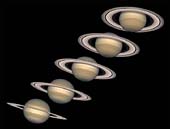
It is difficult to say what is impossible, for the dream of yesterday is
the hope of today and reality of tomorrow.
- Robert Goddard
|
Table of Contents |
|
Saturn Introduction
|
|
Saturn's Moons |
|
Atlas,
Calypso,
Dione,
Enceladus,
Epimetheus,
Helene,
Hyperion,
Iapetus,
Janus,
Mimas,
Pan,
Pandora,
Phoebe,
Prometheus,
Rhea,
Telesto,
Tethys,
Titan,
Possible New Satellites |
|
Saturn Science |
|
Other Resources |
The wind blows at high speeds on Saturn. Near the equator, it reaches velocities of 500 meters a second (1,100 miles an hour). The wind blows mostly in an easterly direction. The strongest winds are found near the equator and velocity falls off uniformly at higher latitudes. At latitudes greater than 35 degrees, winds alternate east and west as latitude increases.
Saturn's ring system makes the planet one of the most beautiful objects in the solar system. The rings are split into a number of different parts, which include the bright A and B rings and a fainter C ring. The ring system has various gaps. The most notable gap is the Cassini [kah-SEE-nee] Division, which separates the A and B rings. Giovanni Cassini discovered this division in 1675. The Encke [EN-kee] Division, which splits the A Ring, is named after Johann Encke, who discovered it in 1837. Space probes have shown that the main rings are really made up of a large number of narrow ringlets. The origin of the rings is obscure. It is thought that the rings may have been formed from larger moons that were shattered by impacts of comets and meteoroids. The ring composition is not known for certain, but the rings do show a significant amount of water. They may be composed of icebergs and/or snowballs from a few centimeters to a few meters in size. Much of the elaborate structure of some of the rings is due to the gravitational effects of nearby satellites. This phenomenon is demonstrated by the relationship between the F-ring and two small moons that shepherd the ring material.
Radial, spoke-like features in the broad B-ring were also found by the Voyagers. The features are believed to be composed of fine, dust-size particles. The spokes were observed to form and dissipate in the time-lapse images taken by the Voyagers. While electrostatic charging may create spokes by levitating dust particles above the ring, the exact cause of the formation of the spokes is not well understood.
Saturn has 30 named satellites and more continue to be discovered.
| Saturn Statistics | |
|---|---|
| Mass (kg) | 5.688e+26 |
| Mass (Earth = 1) | 9.5181e+01 |
| Equatorial radius (km) | 60,268 |
| Equatorial radius (Earth = 1) | 9.4494e+00 |
| Mean density (gm/cm^3) | 0.69 |
| Mean distance from the Sun (km) | 1,429,400,000 |
| Mean distance from the Sun (Earth = 1) | 9.5388 |
| Rotational period (hours) | 10.233 |
| Orbital period (years) | 29.458 |
| Mean orbital velocity (km/sec) | 9.67 |
| Orbital eccentricity | 0.0560 |
| Tilt of axis (degrees) | 25.33 |
| Orbital inclination (degrees) | 2.488 |
| Equatorial surface gravity (m/sec^2) | 9.05 |
| Equatorial escape velocity (km/sec) | 35.49 |
| Visual geometric albedo | 0.47 |
| Magnitude (Vo) | 0.67 |
| Mean cloud temperature | -125°C |
| Atmospheric pressure (bars) | 1.4 |
| Atmospheric composition Hydrogen Helium | 97% 3% |
- Saturn Fly Around.
- Saturn's spokes in rings.
- 60-HST exposures showing a storm in the atmosphere of Saturn.
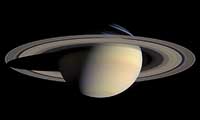 The Greatest Saturn Portrait ...Yet
The Greatest Saturn Portrait ...Yet
While cruising around Saturn in early October 2004, Cassini captured a
series of images that have been composed into the largest, most detailed,
global natural color view of Saturn and its rings ever made.
This grand mosaic consists of 126 images acquired in a tile-like fashion, covering one end of Saturn's rings to the other and the entire planet in between. The images were taken over the course of two hours on Oct. 6, 2004, while Cassini was approximately 6.3 million kilometers (3.9 million miles) from Saturn. Since the view seen by Cassini during this time changed very little, no re-projection or alteration of any of the images was necessary.
Three images (red, green and blue) were taken of each of 42 locations, or "footprints," across the planet. The full color footprints were put together to produce a mosaic that is 8,888 pixels across and 4,544 pixels tall.
The smallest features seen here are 38 kilometers (24 miles) across. Many
of Saturn's splendid features noted previously in single frames taken by
Cassini are visible in this one detailed, all-encompassing view: subtle
color variations across the rings, the thread-like F ring, ring shadows
cast against the blue northern hemisphere, the planet's shadow making its
way across the rings to the left, and blue-grey storms in Saturn's
southern hemisphere to the right. Tiny Mimas and even smaller Janus are
both faintly visible at the lower left.
The Sun-Saturn-Cassini, or phase, angle at the time was 72 degrees; hence,
the partial illumination of Saturn in this portrait. Later in the mission,
when the spacecraft's trajectory takes it far from Saturn and also into
the direction of the Sun, Cassini will be able to look back and view
Saturn and its rings in a more fully-illuminated geometry.
(Courtesy NASA/JPL/Space Science Institute)
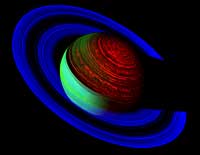 Neon Saturn
Neon Saturn
Flying over the unlit side of Saturn's rings, the Cassini spacecraft
captures Saturn's glow, represented in brilliant shades of electric blue,
sapphire and mint green, while the planet's shadow casts a wide net on the
rings.
On the night side (right side of image), with no sunlight, Saturn's own thermal radiation lights things up. This light at 5.1 microns wavelength (some seven times the longest wavelength visible to the human eye) is generated deep within Saturn, and works its way upward, eventually escaping into space. Thick clouds deep in the atmosphere block that light. An amazing array of dark streaks, spots, and globe-encircling bands is visible instead. Saturn's strong thermal glow at 5.1 microns even allows these deep clouds to be seen on portions of the dayside (left side), especially where overlying hazes are thin and the glint of the sun off of them is minimal. These deep clouds are likely made of ammonium hydrosulfide and cannot be seen in reflected light on the dayside, since the glint of the sun on overlying hazes and ammonia clouds blocks the view of this level.
A pronounced difference in the brightness between the northern and
southern hemispheres is apparent. The northern hemisphere is about twice
as bright as the southern hemisphere. This is because high-level, fine
particles are about half as prevalent in the northern hemisphere as in the
south. These particles block Saturn's glow more strongly, making Saturn
look brighter in the north.
[ more ]
(Courtesy NASA/JPL/University of Arizona)
 Saturn With Rhea and Dione
Saturn With Rhea and Dione
NASA's Voyager 2 took this photograph
of Saturn on July 21, 1981, when the spacecraft was 33.9 million
kilometers (21 million miles) from the planet. Two bright, presumably
convective cloud patterns are
visible in the mid-northern hemisphere and several dark spoke-like
features can be seen in the broad B-ring (left of planet). The moons,
Rhea and Dione, appear
as blue dots to the south and southeast of Saturn, respectively. Voyager
2 made its closest approach to Saturn on August 25, 1981.
(Courtesy NASA/JPL)
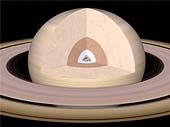 The Interior of Saturn
The Interior of Saturn
This picture illustrates the internal structure of Saturn. The
outer layer is primarily composed of molecular hydrogen. As we
go deeper where the presure reaches 100,000 bars, the gas starts
to resemble a hot liquid. When the hydrogen reaches a pressure
of 1,000,000 bar, hydrogen changes into a new state of metallic
hydrogen. In this state it resembles a molten metal. This metalic
hydrogen state occurs at about half of Saturn's radius. Below
this is a layer dominated by ice where "ice" denotes a soupy
liquid mixture of water, methane, and ammonia under high temperatures
and pressures. Finally at the center is a rocky or rocky-ice core.
(Copyright 2002 Calvin J. Hamilton)
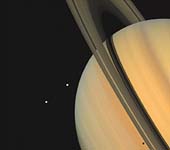 Saturn With Tethys and Dione
Saturn With Tethys and Dione
Saturn and two of its moons, Tethys (above) and
Dione,
were photographed by Voyager 1 on November 3, 1980, from a distance of 13 million
kilometers (8 million miles). The shadows of Saturn's three bright rings
and Tethys are cast onto the cloud tops. The limb of the planet can be
seen easily through the 3,500-kilometer-wide (2,170 mile) Cassini
Division, which separates ring A from ring B. The view through the much
narrower Encke Division, near the outer edge of ring A is less clear.
Beyond the Encke Division (at left) is the faintest of Saturn's three
bright rings, the C-ring or crepe ring, barely visible against the
planet.
(Courtesy NASA/JPL)
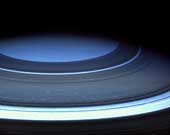 Saturn's Blue Cranium
Saturn's Blue Cranium
Saturn's northern hemisphere is presently a serene blue, more befitting of
Uranus or Neptune,
as seen in this natural color image from Cassini.
Light rays here travel a much longer path through the relatively cloud-free upper atmosphere. Along this path, shorter wavelength blue light rays are scattered effectively by gases in the atmosphere, and it is this scattered light that gives the region its blue appearance. Why the upper atmosphere in the northern hemisphere is so cloud-free is not known, but may be related to colder temperatures brought on by the ring shadows cast there.
Shadows cast by the rings surround the pole, looking almost like dark
atmospheric bands. The ring shadows at higher latitudes correspond to
locations on the ringplane that are farther from the planet--in other
words, the northernmost ring shadow in this view is made by the outer
edge of the A ring.
(Courtesy NASA/JPL/Space Science Institute)
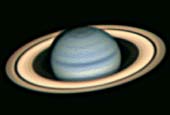 Nordic Optical Telescope
Nordic Optical Telescope
This image of Saturn was taken with the 2.6 meter
Nordic Optical
Telescope, located at La Palma, Canary Islands.
(© Copyright Nordic Optical
Telescope Scientific Association -- NOTSA)
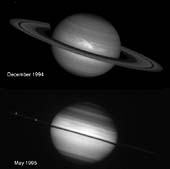 Saturn's Rings Edge-On
Saturn's Rings Edge-On
In one of nature's most dramatic examples of "now-you see-them,
now-you-don't," NASA's Hubble Space Telescope captured Saturn on May 22,
1995, as the planet's magnificent ring system turned edge-on. This
ring-plane crossing occurs approximately every 15 years when the Earth
passes through Saturn's ring plane.
The rings do not disappear completely because the edge of the rings
reflects sunlight. The dark band across the middle of Saturn is the
shadow of the rings cast on the planet (the Sun is almost 3 degrees
above the ring plane.) The bright stripe directly above the ring shadow
is caused by sunlight reflected off the rings onto Saturn's atmosphere.
Two of Saturn's icy moons are visible as tiny starlike objects in or
near the ring plane.
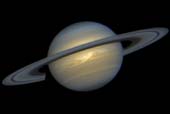 Storm on Saturn
Storm on Saturn
This image, taken by the Hubble Space Telescope, shows a rare storm that
appears as a white arrowhead-shaped feature near the planet's equator.
The storm is generated by an upwelling of warmer air, similar to a
terrestrial thunderhead. The east-west extent of this storm is equal to
the diameter of the Earth (about 12,700 kilometers or 7,900 miles).
The Hubble images are sharp enough to reveal that Saturn's prevailing
winds shape a dark "wedge" that eats into the western (left) side of the
bright central cloud. The planet's strongest eastward winds, clocked at
1,600 kilometers (1,000 miles) per hour based on Voyager spacecraft
images taken in 1980-81, are at the latitude of the wedge.
To the north of this arrowhead-shaped feature, the winds decrease so
that the storm center is moving eastward relative to the local flow. The
clouds expanding north of the storm are swept westward by the winds
at higher latitudes. The strong winds near the latitude of the dark
wedge blow over the northern part of the storm, creating a secondary
disturbance that generates the faint white clouds to the east (right) of
the storm center. The storm's white clouds are ammonia ice crystals that
form when an upward flow of warmer gases shoves its way through Saturn's
frigid cloud tops.
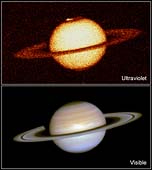 HST Views Aurora on Saturn
HST Views Aurora on Saturn
The top image shows the first image ever taken of bright aurorae at
Saturn's northern and southern poles, as seen in far ultraviolet light
by the Hubble Space Telescope. Hubble resolves a luminous, circular band
centered on the north pole, where an enormous auroral curtain rises as
far as 2,000 kilometers (1,200 miles) above the cloudtops. This curtain
changed rapidly in brightness and extent over the two hour period of HST
observations.
The aurora is produced as trapped charged particles precipitating from the magnetosphere collide with atmospheric gases. As a result of the bombardment, Saturn's gases glow at far-ultraviolet wavelengths (110-160 nanometers). These wavelengths are absorbed by the Earth's atmosphere, and can only be observed from space-based telescopes.
For comparison, the bottom image is a visible-light color composite
of Saturn as seen by Hubble on December 1, 1994. Unlike the
ultraviolet image, Saturn's familiar atmospheric belts and zones are
clearly seen. The lower cloud deck is not visible at UV wavelengths
because sunlight is reflected from higher in the atmosphere.
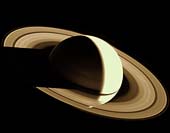 Last View of Saturn
Last View of Saturn
Two days after its encounter with Saturn,
Voyager 1 looked back on the planet
from a distance of more than 5.0 million kilometers (3.0 million miles).
This view of Saturn has never been seen by an earth based telescope,
since the earth is so close to the Sun only the sunlit face of Saturn
can be seen.
(Copyright © 2002 Calvin J. Hamilton)
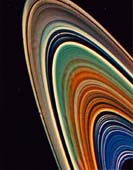 False Color Image of Saturn's Rings
False Color Image of Saturn's Rings
Possible variations in chemical composition from one part of
Saturn's ring system to another are visible in this Voyager 2
picture as subtle color variations that can be recorded with
special computer-processing techniques. This highly enhanced
color view was assembled from clear, orange and ultraviolet
frames obtained August 17, 1981 from a distance of 8.9 million kilometers
(5.5 million miles). In addition to the previously known blue
color of the C-ring and the Cassini Division, the picture shows
additional color differences between the inner B-ring and
and outer region (where the spokes form) and between these and
the A-ring. (Courtesy NASA/JPL)
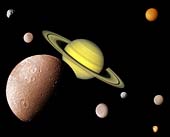 The Saturn System
The Saturn System
This picture of the Saturnian system was prepared from an
assemblage of images taken by the Voyager 1 spacecraft during its Saturn
encounter in November 1980. This view shows
Dione in the forefront, Saturn rising behind,
Epimetheus (top-left) and
Rhea just to the left of Saturn's rings.
To the right and below Saturn's rings are Enceladus,
Mimas, Tethys, and
Iapetus (bottom-right). The cloud covered
Titan is at the top-right.
(Copyright Calvin J. Hamilton)
Saturn has 31 officially recognized and named satellites. In addition, there are other unconfirmed satellites. One circles in the orbit of Dione, a second is located between the orbits of Tethys and Dione, and a third is located between Dione and Rhea. The unconfirmed satellites were found in Voyager photographs, but were not confirmed by more than one sighting. Recently, the Hubble Space Telescope imaged four objects that might be new moons.
Several generalizations can be made about the satellites of Saturn. Only Titan has an appreciable atmosphere. Most of the satellites have a synchronous rotation. The exceptions are Hyperion, which has a chaotic orbit, and Phoebe. Saturn has a regular system of satellites. That is, the satellites have nearly circular orbits and lie in the equatorial plane. The two exceptions are Iapetus and Phoebe. All of the satellites have a density of < 2 gm/cm3. This indicates they are composed of 30 to 40% rock and 60 to 70% water ice. Most of the satellites reflect 60 to 90% of the light that strikes them. The outer four satellites reflect less than this and Phoebe reflects only 2% of the light that strikes it.
The following table summarizes the radius, mass, distance from the planet center, discoverer and the date of discovery of each of the confirmed satellites of Saturn:
| Moon | # | Radius (km) | Mass (kg) | Distance (km) | Discoverer | Date |
|---|---|---|---|---|---|---|
| Pan | XVIII | 9.655 | ? | 133,583 | Mark R. Showalter | 1990 |
| S/2005 S1 | 7 | ? | 136,530 | Cassini Spacecraft | 2005 | |
| Atlas | XV | 20x15 | ? | 137,640 | R. Terrile | 1980 |
| Prometheus | XVI | 72.5x42.5x32.5 | 2.7e+17* | 139,350 | S. Collins & others | 1980 |
| Pandora | XVII | 57x42x31 | 2.2e+17* | 141,700 | S. Collins & others | 1980 |
| Epimetheus | XI | 72x54x49 | 5.6e+17* | 151,422 | R. Walker | 1980 |
| Janus | X | 98x96x75 | 2.01e+18* | 151,472 | Audouin Dollfus | 1966 |
| Mimas | I | 198.6 +- 0.6 | 3.84E+19 | 185,520 | William Herschel | 1789 |
| Enceladus | II | 249.4 +- 0.2 | 8.65E+19 | 238,020 | William Herschel | 1789 |
| Tethys | III | 529.9 +- 1.5 | 6.176E+20 | 294,660 | Giovanni Domenico Cassini | 1684 |
| Telesto | XIII | 17x14x13 | ? | 294,660 | B. Smith & others | 1980 |
| Calypso | XIV | 17x11x11 | ? | 294,660 | B. Smith & others | 1980 |
| Dione | IV | 559. +- 5 | 1.0959E+21 | 377,400 | Giovanni Domenico Cassini | 1684 |
| Helene | XII | 18x16x15 | ? | 377,400 | P. Laques & J. Lecacheus | 1980 |
| Rhea | V | 764. +- 4 | 2.3166E+21 | 527,040 | Giovanni Domenico Cassini | 1672 |
| Titan | VI | 2575.5 +- 2 | 1.345426E+23 | 1,221,850 | Christiaan Huygens | 1655 |
| Hyperion | VII | 205x130x110 | 1.77E+19 | 1,481,000 | William Cranch Bond | 1848 |
| Iapetus | VIII | 730 | 1.88E+21 | 3,561,300 | Giovanni Domenico Cassini | 1671 |
| Kiviuq | XXIV | 7 | 11,365,000 | B. Gladman | 2000 | |
| Ijiraq | XXII | 5 | 11,442,000 | J.J. Kavelaars, B. Gladman | 2000 | |
| Phoebe | IX | 115 x 110 x 105 | 4E+18 | 12,952,000 | William Henry Pickering | 1898 |
| Paaliaq | XX | 9.5 | 15,198,000 | B. Gladman | 2000 | |
| Skathi | XXVII | 3.2 | 15,641,000 | J.J. Kavelaars, B. Gladman | 2000 | |
| Albiorix | XXVI | 13 | 16,394,000 | M. Holman, T.B. Spahr | 2000 | |
| Erriapo | XXVIII | 4.3 | 17,604,000 | J.J. Kavelaars, B. Gladman | 2000 | |
| Siarnaq | XXIX | 16 | 18,195,000 | B. Gladman, J.J. Kavelaars | 2000 | |
| Tarvos | XXI | 6.5 | 18,239,000 | J.J. Kavelaars, B. Gladman | 2000 | |
| S/2003 S1 | 3.3 | 18,719,000 | S.S. Sheppard | 2003 | ||
| Mundilfari | XXV | 2.8 | 18,722,000 | B. Gladman, J.J. Kavelaars | 2000 | |
| Suttungr | XXIII | 2.8 | 19,465,000 | B. Gladman, J.J. Kavelaars | 2000 | |
| Thrymr | XXX | 2.8 | 20,219,000 | B. Gladman, J.J. Kavelaars | 2000 | |
| Ymir | XIX | 8 | 23,130,000 | B. Gladman | 2000 |
Thomas, P., J. Veverka, D. Morrison, M. Davies. and T. V. Johnson. "Saturn's Small Satellites: Voyager Imaging Results." Journal of Geophysical Research, November 1, 1983, 8743-8754.
Soderblom, Laurence A. and Torrence V. Johnson. "The Moons of Saturn." Scientific American, January 1982.

 Return to Jupiter
Return to Jupiter Voyage to Uranus
Voyage to Uranus